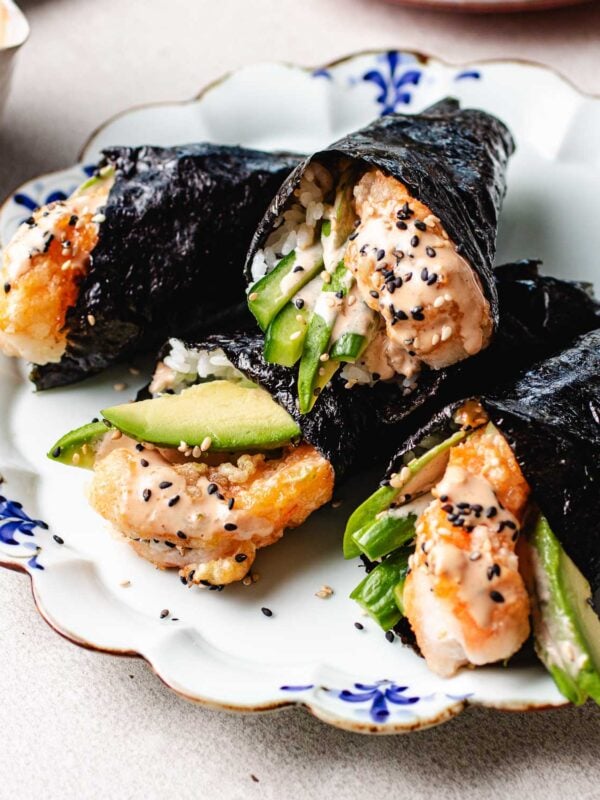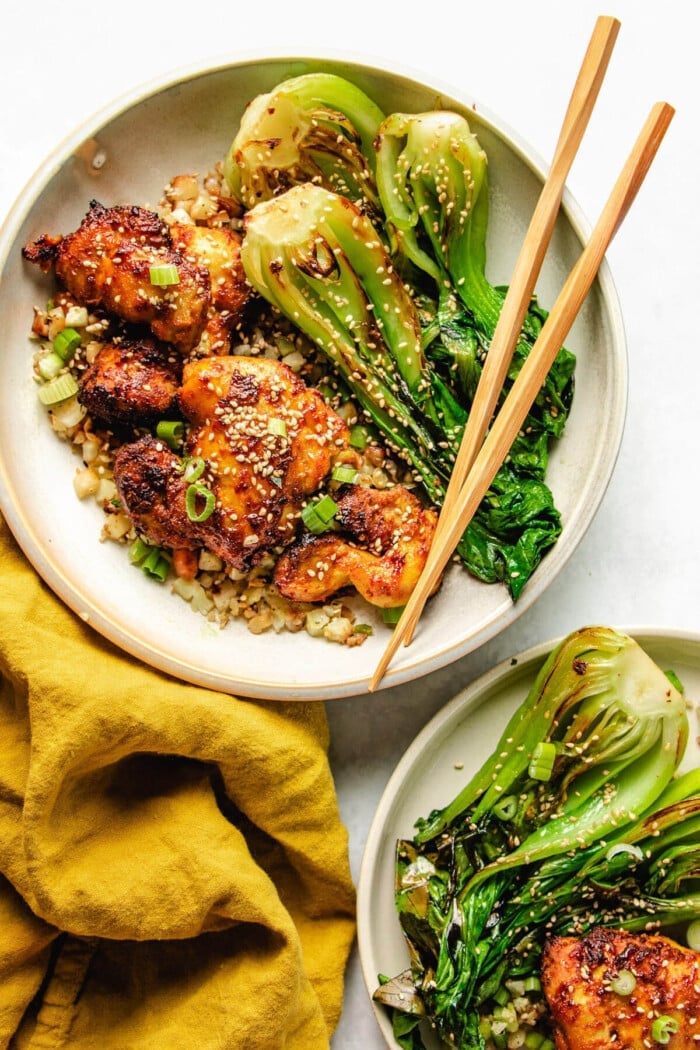This post may contain affiliate links. Please read our disclosure policy.
Saucy, nutty, savory, and just the right amount of heat—these Taiwanese Dan Dan Noodles are loaded with crispy pork crumbles, a glossy sesame dan dan sauce, and all the cozy, comforting flavors you’d expect from a dish that tastes like it took hours… but comes together fast.
Taiwanese dan dan mian is a little sweeter and more homey than the Sichuan original. There’s no marinating, no broth—just a quick stovetop stir-fry and a pantry-friendly sauce I’ve made more times than I can count. If you’ve been craving something bold, cozy, and seriously satisfying, I’ll show you exactly how to bring this authentic Taiwanese favorite to your own kitchen.

Table of Contents
Taiwanese vs. Sichuan dan dan noodles
Dan Dan Mian comes from Sichuan, and they’re known for being bold, spicy, and full of that signature numbing heat. My grandma was from Sichuan, so I grew up eating the real deal—super punchy, flavorful, and definitely not shy on the spice.
This version, though, is Taiwanese. Think of it as a homey, everyday take on the original—still savory and rich, but a little more mellow. The flavors lean slightly sweet, the pork is crispy and well-seasoned, and the spice is balanced. It’s a dish that’s easier on the palate, family-friendly, and surprisingly easy to make with a few pantry swaps.
Main Ingredients (and Smart Substitutions)
Taiwanese thick soy sauce (or soy paste):
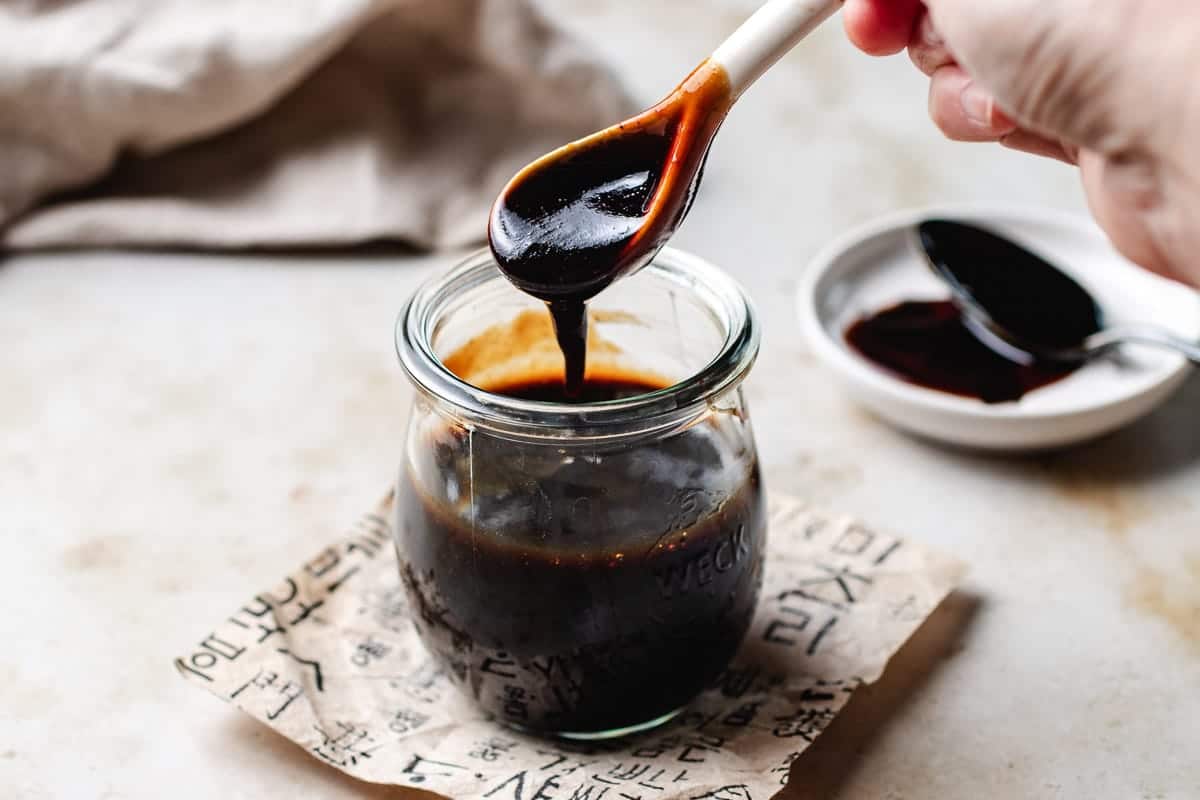
Save This Recipe
This is a sweet-savory, viscous soy sauce—think of it like a soy-based glaze. It’s traditionally made by soy sauce with glutinous rice flour (to thicken), garlic, sugar, and sometimes sweeteners like licorice. The result is glossy, rich, and slightly sweet—perfect for balancing the savory umami of pork.
- Substitute tip: If you use dark soy sauce instead, stir in ½–1 tsp sugar to mimic the sweetness and viscosity.
Pickled mustard greens or ya cai:

These preserved mustard greens offer a salty, tangy, slightly funky depth that cuts through the richness of the crisped ground pork—not only adding brightness but also enhancing the overall balance of the dish
- Substitution tip: If you can’t find them, use diced pickled cucumbers or pickled cornichons for a lighter but still bright flavor.
This is made from deeply toasted sesame seeds—stronger, richer, and more aromatic than tahini. Roasted tahini (like Soom brand) works in a pinch. Peanut butter will make the dish too sweet, I don’t recommend it.
Not spicy, but tingly. Toast them lightly and crush for the best aroma. If you’re sensitive to the numbing sensation, use less or omit.
Noodles:
Thin Chinese wheat noodles are traditional. For gluten-free, look for rice-based ramen or soba-style noodles that hold up well and don’t get mushy.
How to make Taiwanese dan dan noodles
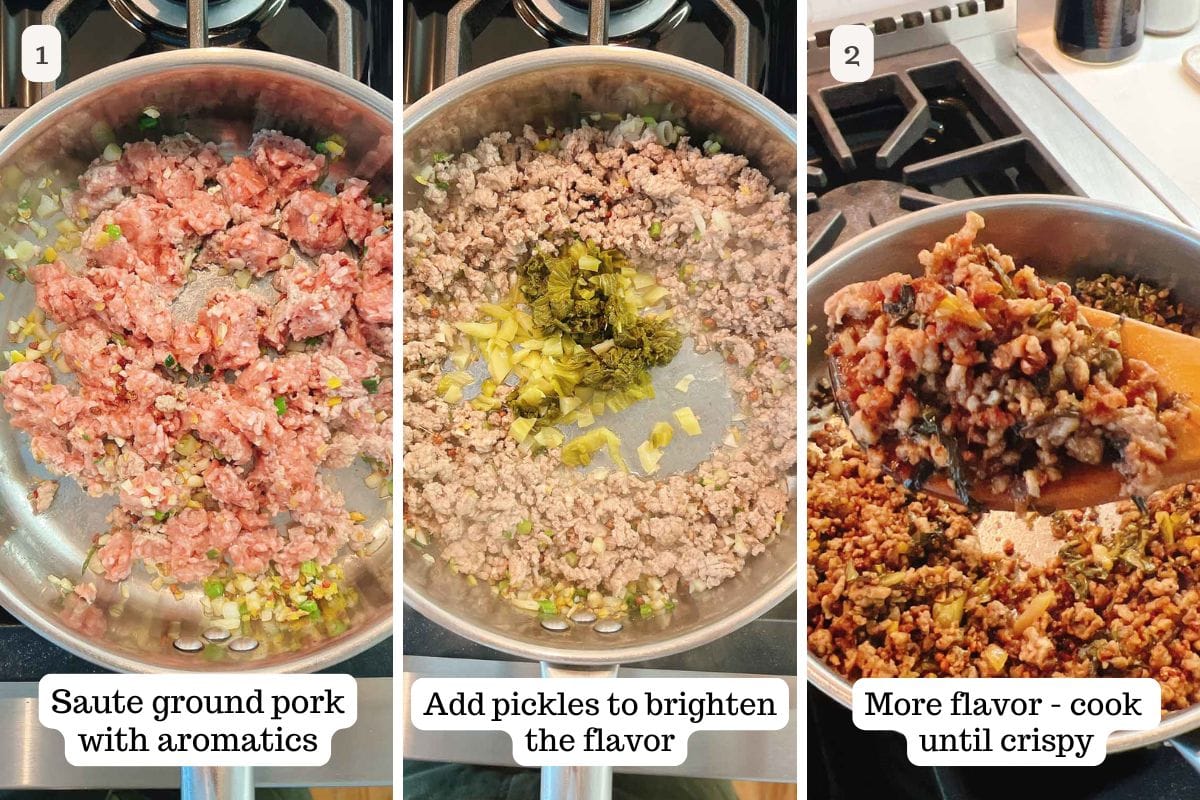
Step 1: Prepping aromatics for a flavorful base
Garlic, ginger, and green onion white parts are sautéed first to build the foundation for the pork topping. These ingredients infuse the oil and create the starting layer of flavor. Chopping them finely helps them blend into the sauce instead of standing out in chunks.
Note: If the pan is too hot and the aromatics burn, it’ll leave a bitter flavor in the pork—so work fast and control your heat.
Step 2: Making ground pork extra flavorful, not greasy or bland
Crisping the pork over medium heat helps build deep flavor and texture. If the pan is overcrowded or the heat’s too low, the meat will steam instead of browning—it’ll taste flat and greasy instead of rich and savory. The goal is small, evenly browned crumbles with no excess moisture.
Once the pork is cooked through and you add the seasonings, turn the heat up to medium-high. This final step lets the fat render and the sauce reduce. You’ll know it’s ready when the pork turns golden and crisp around the edges—almost like bacon bits. That texture is what makes the topping so satisfying.
Step 3: Why use mustard greens and what do they do?
Pickled mustard greens bring a salty-tangy note that cuts through the pork’s richness. They balance the fat and add brightness to the overall dish. Without them, the pork topping may feel heavy or one-dimensional.
Tip: Make sure to sauté until the moisture cooks off. If not, the pork will stay wet and won’t be as tasty.

Step 4: Keeping noodles from clumping or turning soggy
Noodles should be cooked just until al dente, shaked away excess moisture, and tossed with a little oil while still hot. This prevents the noodles from clumping and keeps the texture springy. Overcooked noodles will absorb too much liquid and become mushy.
Tip: Save your noodle water before draining and use it for adjusting the dan dan sauce later.
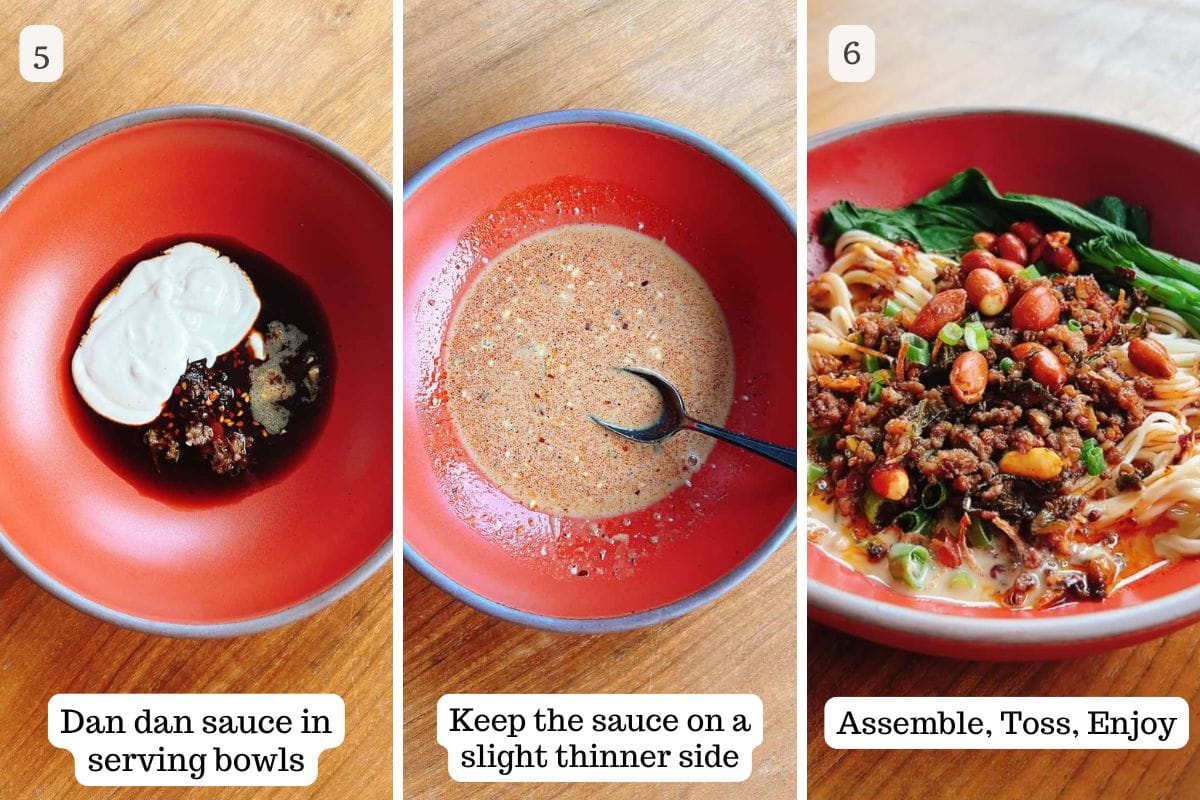
Step 5: Getting the dan dan sauce texture just right
The sesame paste mixture should look a little thin after you stir in hot noodle water. That’s the goal—it’ll thicken once tossed with the noodles. A sauce that’s too thick or too salty usually means not enough liquid or missing acidity from vinegar.
Step 6: Assembling for the best texture in every bite
To serve, layer the noodles with pork, scallions, peanuts, and greens. Toss everything well so the sauce coats every strand. Eat right away for the best experience—waiting too long will make the noodles soak up too much sauce and lose that silky texture.
???
Dry vs. Soupy Dan Dan Mian: What’s the Difference?
This recipe is for dry-style Dan Dan Noodles—the kind that’s tossed in a flavorful, nutty sauce with crispy pork on top. There’s no broth, but the dan dan sauce is loose enough to coat the noodles and bring everything together.
The soupy version, more common in some Sichuan restaurants, includes a spicy broth made with chili oil, soy sauce, and sometimes bone broth or stock. It’s bolder, spicier, and meant to be sipped like soup.
If you’re looking for that restaurant-style spicy broth noodle, check out my Dan Dan Noodle Soup—it’s Sichuan-inspired, spicy, and slurpable, with a rich, flavorful broth you can enjoy by the spoonful.
Great pairings for the noodles
This dish is rich, savory, and full of flavor, so it pairs best with cool, crisp, or lightly cooked sides that help balance the meal.
- Chinese smashed cucumber salad – Crunchy with a light garlic-soy dressing.
- Pickled daikon – Bright, tangy, and palate-cleansing.
- Silken tofu with sesame dressing – Creamy, chilled, and nutty.
- Stir-fried choy sum – Lightly garlicky and quick to make.
Try these sister recipes next!
If you enjoyed this version, here are a few more to explore:
- Paleo dan dan mian – A lighter version made with zucchini noodles!
- Sichuan dan dan noodle soup – A spicy, brothy take inspired by the original.
Taiwanese dan dan noodles recipe
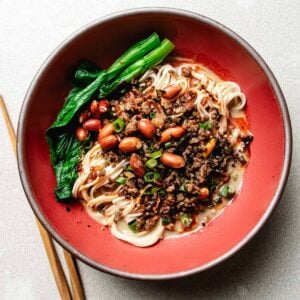
Ingredients
For the ground pork:
- 1 oz garlic cloves finely minced, 5 large
- 0.35 oz. ginger finely minced, half of one thumb
- 2-3 bulb green onions
- 2.5 tbsp Pickled mustard greens or ya cai, or pickled cucumber
- 1 tbsp avocado oil or any neutral flavored oil
- 1-2 tsp Sichuan peppercorns
- 1 lb ground pork
- 1 tbsp light soy sauce
- 2 tsp Taiwanese thick soy sauce sweet soy paste, or 1 tsp dark soy sauce + 1/2 tsp sugar
- 2 tbsp Taiwanese michu or Chinese cooking wine (clear version)
- 1 tsp Five spice powder
For each serving bowl (makes 1 serving):
- 50 gram thin Chinese wheat noodles or any gluten-free noodles
- 2 tsp light soy sauce
- 2 tsp Taiwanese thick soy sauce or 1 tsp dark soy sauce + 1/2 tsp sugar (see notes)
- 2 tsp Chinese black vinegar or aged balsamic vinegar
- 1 tsp Chili garlic sauce or chili oil (optional)
- 1 tbsp Chinese sesame paste or roasted tahini
- 1 small clove garlic, grated
- 2 tbsp noodle boiling water or more
Garnish:
- small handful Roasted peanuts
- Blanched yu choy or Chinese broccoli, or baby bok choy
Instructions
PREP:
- Finely mince the garlic and ginger. Dice green onions into small rounds and separate the white and green parts. For the pickled mustard greens, dice them into small bite-size pieces.
Cook the pork:
- Preheat a large (12-inch) sauté pan over medium heat until hot. Add the oil, garlic, ginger, white scallion parts, and Sichuan peppercorns. Quickly sauté for about 10 seconds, just until fragrant—don’t let the aromatics burn. Lower the heat if needed.
- Add the ground pork. Use a wooden spoon to break it up into small crumbles. Sauté over medium heat until the pork is no longer pink, about 5–6 minutes.
- Add the pickled mustard greens and continue sautéing until most of the moisture has evaporated, about 3–4 minutes.
- Add the soy sauce, soy paste, michu, and five spice powder. Turn the heat up to medium-high and sauté for another 7–8 minutes, until the pork becomes deeply browned and crisp around the edges, like bacon bits. Turn off the heat and set aside.
Boil the Noodles & Blanch the Greens:
- Bring a large pot of water to a boil. Blanch the vegetables and transfer them to a bowl of cold water. Drain and gently squeeze out the excess moisture.
- Use the same pot to boil the noodles according to the package instructions. Before draining, scoop out some noodle cooking water and set it aside (you’ll use this to thin out the sesame paste).
Seasoning the serving bowls:
- In each serving bowl, add the light soy sauce, soy paste, vinegar, chili garlic sauce (if using), sesame paste, grated garlic, and 2 tablespoons of hot noodle water. Stir everything together until the sesame paste turns smooth and creamy.
- Add more noodle water as needed—the sauce should be on the thinner side, since it will thicken when the noodles are tossed in.
Assemble and garnish:
- Divide the cooked noodles into the seasoned bowls. Top with pork crumbles, green scallion parts, roasted peanuts, and a few pieces of blanched greens. Drizzle with more chili oil if desired. Toss everything together until the noodles are evenly coated in sauce. Serve immediately while hot.
Notes
- Taiwanese soy paste (Taiwanese thick soy sauce): This is a sweet, savory, and slightly thick soy sauce. It’s lighter than oyster sauce but sweeter than dark soy sauce. The texture is similar to oyster sauce.
- Substitute: If using dark soy sauce, balance the saltiness with ½ to 1 tsp of sugar to mimic the sweet-salty flavor of Taiwanese soy paste.
- Chinese pickled mustard greens: These fermented greens are salty, tangy, and slightly sour. They bring balance and brightness to the rich pork mixture.
- Substitute: If you can’t find them, use pickled cucumbers (finely diced). They’ll taste a little brighter and less salty but still add a nice contrast.
- Note: If you’re skipping the mustard greens or using a less salty substitute, increase the soy sauce or salt in the pork mixture slightly to make up for the missing flavor.
- Traditional Dan Dan Noodles use thin, round Chinese wheat noodles for their firm bite and springy texture. If you’re gluten-free, this gluten-free ramen noodle is a great substitute that holds up well.
- Flavor tip – crisp up the pork: Cooking the pork until the fat renders out and the crumbles get crispy makes the dish extra flavorful—don’t skip this part!
- Chinese sesame paste vs. Roasted tahini paste: Chinese sesame paste is made from deeply roasted sesame seeds, giving it a richer, more aromatic flavor with less bitterness. Roasted tahini (like Soom) is a better substitute than raw tahini, though it still leans slightly more bitter. It’ll work if that’s what you have, but the flavor won’t be as bold or toasty as the Chinese version.
- Balancing saltiness: Some readers say Dan Dan Noodles are too salty—but here’s why:
- The serving bowl sauce is well-seasoned, and so is the pork topping.
- But once it’s tossed with plain boiled noodles, the overall flavor mellows out and becomes balanced.
- If you’re not using pickled mustard greens (or ya cai), remember they contribute salt and sourness. Without them, the pork may taste flat unless you add more soy sauce or salt to balance it out.
- Dan Dan sauce consistency: The sauce in each bowl will look thin at first, but that’s intentional. Once the noodles are tossed in, the starch thickens the sauce. Start thinner—you can always add a splash of noodle water to loosen it up if needed.
- Make-ahead, storage & reheating tips:
- The pork topping can be made up to 4 days ahead and stored in an airtight container in the fridge.
- The Dan Dan sauce base (everything in the individual bowl) keeps well for 3–4 days in the fridge—just stir in hot noodle water before serving.
- To reheat the pork, microwave on medium power for 1 minute or warm it in a skillet.
- To loosen cold sauce, add hot water 1 tablespoon at a time and stir until smooth.
Nutrition
Nutrition information is automatically calculated, so should only be used as an approximation.
Made a dish and loved it? Please rate the recipe and leave a comment in the section below! It helps my blog grow organically, allowing me to continue sharing free and awesome content with you. Thank you!

